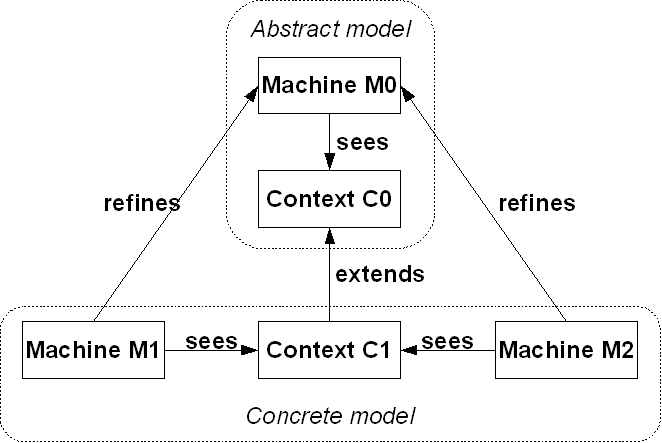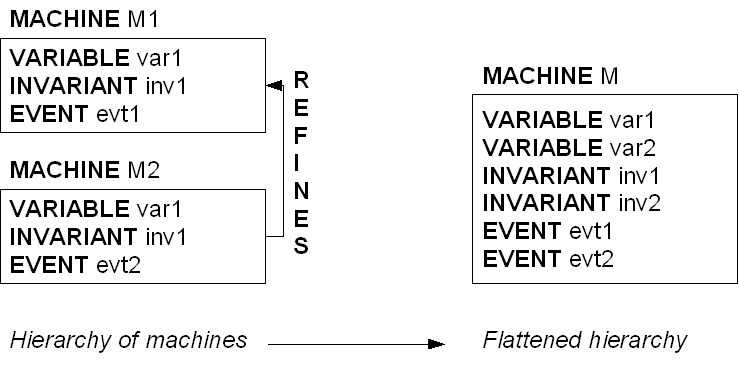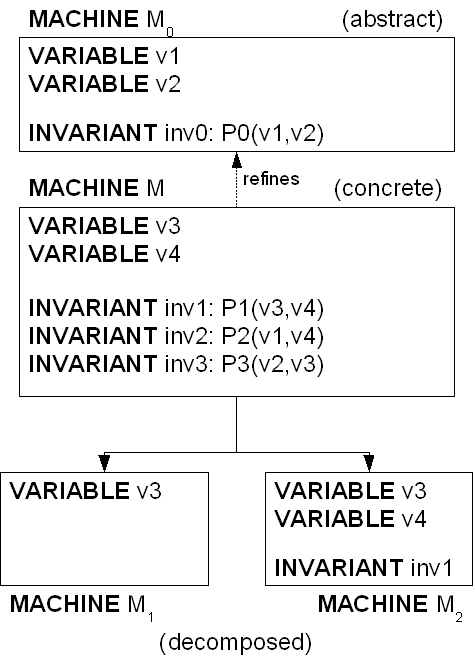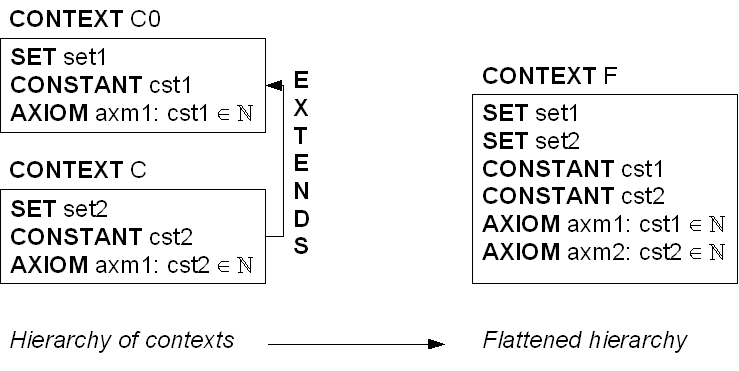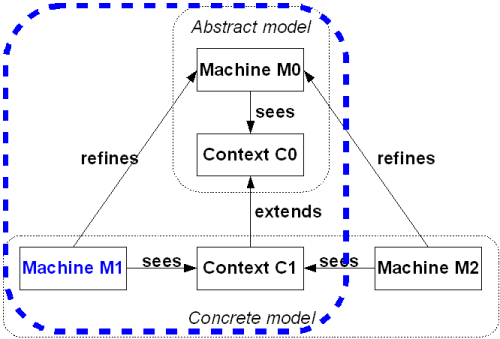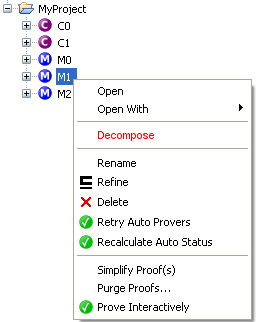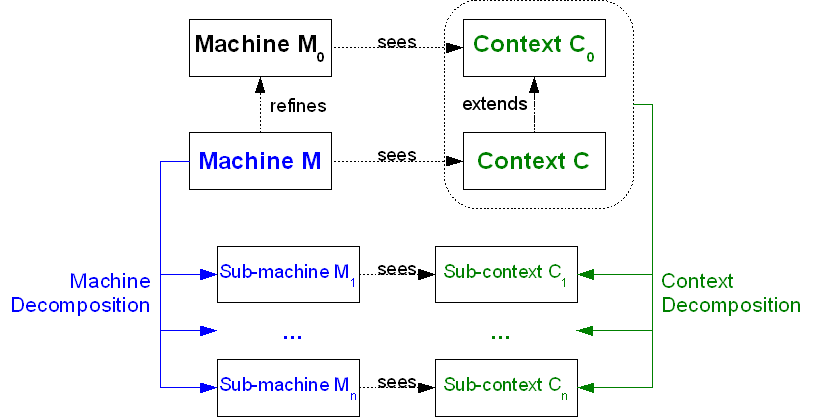Event Model Decomposition: Difference between revisions
imported>Pascal |
imported>Pascal |
||
| Line 235: | Line 235: | ||
===== Propagating the external status ===== | ===== Propagating the external status ===== | ||
An event tagged as ''external'' in the non-decomposed machine (when | An event tagged as ''external'' in the non-decomposed machine (when resulting from a previous decomposition) shall remain ''external'' in the sub-machine. | ||
===== Ensuring that an external event cannot be refined ===== | ===== Ensuring that an external event cannot be refined ===== | ||
Revision as of 07:27, 7 July 2009
Introduction
One of the most important feature of the Event-B approach is the possibility to introduce new events during refinement steps, but a consequence is an increasing complexity of the refinement process when having to deal with many events and many state variables.
The main idea of the decomposition is to cut a model  into sub-models
into sub-models  , which can be refined separately and more comfortably than the whole.
, which can be refined separately and more comfortably than the whole.
The constraint that shall be satisfied by the decomposition is that these refined models might - the recomposition will never be performed in practice - be recomposed into a whole model  in a way that guarantees that
in a way that guarantees that  refines
refines  . An event-based decomposition of a model is detailed in the Event Model Decomposition article: the events of a model are partitioned to form the events of the sub-models. In parallel, the variables on which these events act are distributed among the sub-models.
. An event-based decomposition of a model is detailed in the Event Model Decomposition article: the events of a model are partitioned to form the events of the sub-models. In parallel, the variables on which these events act are distributed among the sub-models.
The purpose is here to precisely describe what is required at the Rodin platform level to integrate this event model decomposition, and to explain why. The details of how it could be implemented are out of scope.
Terminology
- Event model decomposition: The decomposition of a model, as defined in the modelling language, in sub-models. Other decomposition structures for Event-B are not considered here.
A model can contain contexts, machines, or both. The notion of model decomposition covers on the one hand the machine decomposition, and on the other hand the context decomposition, both being interdependent.
- Sub-machine: A machine built from a non-decomposed machine during the event model decomposition.
- Sub-context: A context built from a non-decomposed context during the event model decomposition.
- Shared variable: A variable of a given machine which is accessed by events distributed in distinct sub-machines (by opposition to private variable).
- Private variable: A variable of a given machine which is only accessed by events of the same sub-machine (by opposition to shared variable).
- External event: An event of a sub-machine which is built from an event of the non-decomposed machine, and which simulates the way the shared variables (between this sub-machine and another sub-machine) are handled in the non-decomposed machine (by opposition to internal event).
- Internal event: An event copied from the non-decomposed machine to a sub-machine, according to the end-user specified distribution (by opposition to external event).
Note that a variable is said to be accessed when it is read or written. More precisely, such an access may be performed by a predicate (invariant, guard, witness) or in an assignment (action).
Low-level Specification
The low-level specification details through several steps how the event model decomposition shall be performed, and in which order. It establishes a distinction between the steps performed on the end-user's initiative, and the computed ones. It links when possible to the already implemented features of the Rodin platform which can be used at some steps.
Decomposition of a machine in sub-machines
The purpose of this paragraph is to specify how to decompose a machine in sub-machines.
The hierarchy of machines (see the  clauses) shall be first flatten (virtually or not), as illustrated below. The resulting machine is considered as being the non-decomposed machine from which the sub-machines shall be built.
clauses) shall be first flatten (virtually or not), as illustrated below. The resulting machine is considered as being the non-decomposed machine from which the sub-machines shall be built.
Note that it may be necessary to rename some variables or invariants.
About the variables
Some variables are needed by several sub-machines of the decomposition. As a consequence, these variables shall be replicated in the sub-machines. Beyond that, since it is not possible to ensure that such a variable will be refined in the same way in each sub-machine, they shall be given a special status (shared variable), with the limitation that they cannot be refined.
We will specify in this section how to introduce the notion of shared variable in the Rodin platform, and how to check the associated rules.
The following DTD excerpt describes the structure of a variable in the Rodin database:
<!ENTITY % NameAttDecl "name CDATA #REQUIRED"> <!ENTITY % CommentAttDecl "org.eventb.core.comment CDATA #IMPLIED"> <!ENTITY % IdentAttDecl "org.eventb.core.identifier CDATA #REQUIRED"> <!ELEMENT %variable; EMPTY> <!ATTLIST %variable; %NameAttDecl; %CommentAttDecl; %IdentAttDecl; >
A first possibility to tag a variable as shared would be to add a shared specific attribute, which would be set to true if and only if the variable is shared:
<ENTITY % shared "org.eventb.core.shared CDATA #REQUIRED"> <!ELEMENT %variable; EMPTY> <!ATTLIST %variable; ... %shared; (false|true) #REQUIRED >
Another possibility would be to define a more generic attribute, which could take different values, according to the nature of the variable:
<ENTITY % nature "org.eventb.core.nature CDATA #REQUIRED"> <!ATTLIST %variable; ... %nature; (0|1) #REQUIRED >
The second option, which has the main advantage to be more scalable, is retained here.
A shared variable shall always be present in the state space of any refinement of the component. The verification shall be added to those already performed by the static checker. The static checker shall have a way to determine if a given variable is shared or not.
Partitioning the variables in the sub-machines of the decomposition
The first question raised by the partition of the variables is whether it shall be the first stage of the decomposition, or not. Let's first suppose that the answer is "yes". The case where  is an event that accesses a variable
is an event that accesses a variable  associated to a sub-machine
associated to a sub-machine  and a variable
and a variable  associated to a sub-machine
associated to a sub-machine  cannot be successfully handled: should
cannot be successfully handled: should  be associated to
be associated to  or to
or to  ? Moreover, contrary to the events, the variables are not essentially bearers of meanings, and they cannot by themselves guide the decomposition.
? Moreover, contrary to the events, the variables are not essentially bearers of meanings, and they cannot by themselves guide the decomposition.
As a consequence, it is pertinent to assume that the events have been first partitioned. The following cases have then to be taken into consideration when dealing with the variable distribution:
- If
 is a variable that is only accessed by events of a given sub-machine
is a variable that is only accessed by events of a given sub-machine  , then
, then  is a private variable of
is a private variable of  . It shall be moved to
. It shall be moved to  .
. - If
 is a variable that is accessed by events of distinct sub-machines
is a variable that is accessed by events of distinct sub-machines  , then
, then  is a shared variable. It shall be tagged as such and duplicated in all sub-machines.
is a shared variable. It shall be tagged as such and duplicated in all sub-machines.
If all the variables are shared at the conclusion of the partition, the end user shall be notified (it certainly means that the decomposition was not judicious!).
Propagating the sharing status
A variable tagged as shared in the non-decomposed machine (when resulting from a previous decomposition) shall remain shared in the sub-machines.
About the events
It shall be possible to simulate the way the shared variables are handled in the non-decomposed machine. This is precisely the purpose of the so-called external events.
We will examine in this section how to define such events in the Rodin platform, how to construct them, and how to enforce the rules that apply (in particular, these events cannot be refined).
Identifying an event as external
An attribute is already defined, which is introduced below, to precise the nature of an event. A first solution would be to add another masked value (eg. 4) to encode the external status.
<!ENTITY % convergence "org.eventb.core.convergence"> <!ATTLIST %event; ... %convergence; (0|1|2) #REQUIRED ... >
Another solution would be to add a distinct external attribute, which would be set to true if and only if the event is external:
<ENTITY % external "org.eventb.core.external CDATA #REQUIRED"> <!ATTLIST %event; ... %external; (false|true) #REQUIRED >
This solution is preferred because the notion of external event is totally orthogonal to the notion of convergence.
Constructing an external event
The construction of an external event highly relies on some rewriting / simplification rules. It is recommended to peruse them before reading further.
 is an event of
is an event of  ,
,  are private variables of
are private variables of  ,
,  are shared variables between
are shared variables between  and the destination sub-machine (i.e. the sub-machine where the external event will be dispatched),
and the destination sub-machine (i.e. the sub-machine where the external event will be dispatched),  are before-after predicates of
are before-after predicates of  , and
, and  is a predicate of
is a predicate of  .
.
Generic construction
We first focus on the generic construction of an external event from an event of a sub-machine  whose action is expressed as follows:
whose action is expressed as follows:
e WHERETHEN

- The first step of the construction consists in replacing the private variables by parameters. Note that this step is purely fictive, because assigning an event parameter is not allowed! e ANY
- The second step consists in adding guards to define the types of the parameters, if necessary. More precisely, a theorem shall be added for each parameter for which typing is required. The .bcm file associated to the non-decomposed machine shall be parsed in order to retrieve the typing information.
- The third and last step of the construction consists in introducing an existential quantifier to resolve the invalid assignment.
 is the newly built external event.
external_e
ANY
is the newly built external event.
external_e
ANY
 WHERE
WHERE
 THEN
THEN

 WHERE
WHERE
 THEN
THEN

Derived constructions
Then, it is possible to derivate the construction for other actions:
- Rewriting rules 1 to 5 shall be first applied as many times as possible, from left to right, to get the action into the generic form introduced before.
- Then, the steps detailed for the generic construction shall be followed.
- Then, the simplification rules 6 to 8 shall be enforced.
- Finally, the rewriting rules 1 to 4 shall be applied, from right to left.
Thus, if  is equal to
is equal to  , and if there is no private variable (i.e. there is no existential quantifier on the right-hand side of the assignments), then
, and if there is no private variable (i.e. there is no existential quantifier on the right-hand side of the assignments), then  shall be rewritten as
shall be rewritten as  .
.
The proof obligations generated for deterministic actions are indeed more suitable than those generated for non-deterministic actions.
In the same manner, if  is equal to
is equal to  , and if there is no private variable (i.e. there is no existential quantifier on the right-hand side of the assignments), then
, and if there is no private variable (i.e. there is no existential quantifier on the right-hand side of the assignments), then  shall be rewritten as
shall be rewritten as  .
.
For a given set  , proving that
, proving that  (FIS proof obligation generated from
(FIS proof obligation generated from  ) is indeed not as "simple" as proving that
) is indeed not as "simple" as proving that  (proof obligation generated from
(proof obligation generated from  ).
).
Example
e WHERETHEN
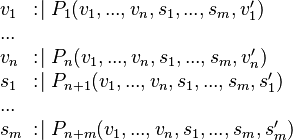
external_e ANYWHERE
THEN

In this example, the rules 4, 7 and 8 shall be applied.
Partitioning the events in the sub-machines of the decomposition
The following sequence shall be followed:
- The events shall be first partitioned, as indicated by the end-user. More precisely, machines shall be created, according to this partition. At this step, the machines shall only contain the specified events. In particular, the
 and
and  clauses shall be empty. Moreover, note that it may be necessary to rename some events when performing the partition.
clauses shall be empty. Moreover, note that it may be necessary to rename some events when performing the partition. - The Rodin platform shall then be able to distribute the variables, according to the event partition (see Variable partition).
- The Rodin platform shall be able to distribute the invariants, according to the variable partition (see Invariant partition).
- If
 is an event that modifies a shared variable
is an event that modifies a shared variable  (i.e.
(i.e.  is listed among the free identifiers on the left-hand side of an assignment), then an external event that modifies
is listed among the free identifiers on the left-hand side of an assignment), then an external event that modifies  shall be built from
shall be built from  in each sub-machine where
in each sub-machine where  is accessed.
is accessed.
N.B. : Note that the construction of an external event depends on the source sub-machine (i.e. the sub-machine containing the internal event  from which the external event is to be built) and on the destination sub-machine (i.e. the sub-machine where the external event is to be built).
from which the external event is to be built) and on the destination sub-machine (i.e. the sub-machine where the external event is to be built).
Building an external event from a given event  modifying a shared variable
modifying a shared variable  and duplicating it in each sub-machine where
and duplicating it in each sub-machine where  is accessed does not indeed entirely fit the requirements, as illustrated below: the sub-machine
is accessed does not indeed entirely fit the requirements, as illustrated below: the sub-machine  does not know the shared variable
does not know the shared variable  and the sub-machine
and the sub-machine  does not know the shared variable
does not know the shared variable  .
.
Propagating the convergence status
A sub-machine can be seen as a new abstract machine. As a consequence, the convergence status of a given event shall be propagated in the sub-machines as described below:
- An event tagged as ordinary in the non-decomposed machine shall remain ordinary in the sub-machine.
- An event tagged as convergent in the non-decomposed machine shall become ordinary in the sub-machine.
- An event tagged as anticipated in the non-decomposed machine shall remain anticipated in the sub-machine.
- An external event shall always be declared as ordinary.
See the modelling language for precisions on the convergence status.
Propagating the extended status
An event (external or not) of a sub-machine shall always be declared as non-extended.
Propagating the external status
An event tagged as external in the non-decomposed machine (when resulting from a previous decomposition) shall remain external in the sub-machine.
Ensuring that an external event cannot be refined
The verification shall be performed by the static checker. The static checker shall have a way to determine if a given event is external or not.
Decomposing the initialization event
An initialization event shall be built in each sub-machine from the initialization event of the non-decomposed machine, and according to the distribution of the variables among these sub-machines. The construction is detailed below.  is the initial event and
is the initial event and  the built event,
the built event,  are variables (private or shared) of the sub-machine containing
are variables (private or shared) of the sub-machine containing  ,
,  are variables of other sub-machines,
are variables of other sub-machines,  is a before-after predicate and
is a before-after predicate and  is a predicate.
is a predicate.
initialization THEN
Only the variables of the considered sub-machine shall appear in the built initialization event; other variables shall become bound:
e THEN
The derived cases and simplification rules introduced during the construction of the external events apply here as well.
About the invariants
We will see in this section how to distribute the invariants among the sub-machines, once the variables have been partitioned.
- Case 1: If
 is an invariant only involving private variables of a given sub-machine, then it shall be copied in this sub-machine.
is an invariant only involving private variables of a given sub-machine, then it shall be copied in this sub-machine. - Case 2: If
 is an invariant involving private variables of distinct sub-machines, then it shall not be copied.
is an invariant involving private variables of distinct sub-machines, then it shall not be copied. - Case 3: If
 is an invariant only involving shared variables, then it shall only be copied in the sub-machines containing all these variables.
is an invariant only involving shared variables, then it shall only be copied in the sub-machines containing all these variables. - Case 4: If
 is an invariant involving private variables and shared variables, then it shall only be copied in the sub-machines containing all these variables.
is an invariant involving private variables and shared variables, then it shall only be copied in the sub-machines containing all these variables.
These different cases are illustrated in the figure below, where  ,
,  ,
,  and
and  are predicates.
are predicates.  is an abstract machine,
is an abstract machine,  is a concrete machine extending
is a concrete machine extending  ,
,  is the flattened machine for
is the flattened machine for  and
and  (see how flattening a hierarchy of machines), and
(see how flattening a hierarchy of machines), and  ,
,  , and
, and  are the sub-machines resulting from the decomposition of
are the sub-machines resulting from the decomposition of  .
.  is a private variable of
is a private variable of  ,
,  is a variable shared between
is a variable shared between  and
and  ,
,  is a variable shared between
is a variable shared between  and
and  , and
, and  is a private variable of
is a private variable of  .
.
To summarize, an invariant based on a  predicate is copied in a sub-machine
predicate is copied in a sub-machine  if and only if
if and only if  contains the
contains the  variables.
variables.
If an invariant is used for typing but it has not been copied, a theorem shall be added in the sub-machines for each variable for which typing is required (otherwise a problem will be detected by the static checker). Note that there is no contradiction with the requirements on proof obligations; no proof obligation (PO) is indeed generated for predicates  , where
, where  is a variable and
is a variable and  is a type.
is a type.
Beyond that, a workaround exists if an invariant  , based on a
, based on a  predicate, seems useful (for example an invariant between a concrete variable and some abstract variable) but it has disappeared in a sub-machine
predicate, seems useful (for example an invariant between a concrete variable and some abstract variable) but it has disappeared in a sub-machine  containing variables
containing variables  (eg.
(eg.  and
and  have both been excluded from
have both been excluded from  machine by application of the stated rules). It is indeed possible to add in the non-decomposed machine a theorem based on
machine by application of the stated rules). It is indeed possible to add in the non-decomposed machine a theorem based on  , but where the variables
, but where the variables  become bound, and then to perform again the decomposition. It will lead to a new proof obligation in the non-decomposed machine, which does not pose any difficulty.
become bound, and then to perform again the decomposition. It will lead to a new proof obligation in the non-decomposed machine, which does not pose any difficulty.
For example, if a theorem  , with
, with  , is added to the
, is added to the  concrete machine, then it will be copied in the sub-machine
concrete machine, then it will be copied in the sub-machine  during the decomposition (see case 1). In order to prove the
during the decomposition (see case 1). In order to prove the  statement, the bound variable
statement, the bound variable  shall obviously be instantiated with
shall obviously be instantiated with  .
.
About the variants
As mentioned before, there is no convergent event in sub-machines. As a consequence, there is no need to take the variants into consideration when performing the decomposition.
Decomposition of a context in sub-contexts
The purpose of this paragraph is to specify how to decompose the contexts, according to the decomposition of the machines, and to establish how to link the sub-contexts to the sub-machines.
The hierarchy of contexts (see the  clauses) shall be first accumulated in a single context. More precisely, a new context shall be built (virtually or not), which contains all the carrier sets, constants and axioms of the hierarchy. This context is assumed to be the non-decomposed context from which the sub-contexts shall be built.
clauses) shall be first accumulated in a single context. More precisely, a new context shall be built (virtually or not), which contains all the carrier sets, constants and axioms of the hierarchy. This context is assumed to be the non-decomposed context from which the sub-contexts shall be built.
Note that it may be necessary to rename some axioms when flattening the hierarchy.
Then, an empty context shall be built for each sub-machine  , by respecting the following sequence: the constants shall be first included, then the carrier sets shall be added, and finally the axioms shall be considered.
, by respecting the following sequence: the constants shall be first included, then the carrier sets shall be added, and finally the axioms shall be considered.
This context shall be linked to  through its
through its  clause. Note that, at the conclusion of the context decomposition, the sub-contexts that may be empty shall not be kept, and a
clause. Note that, at the conclusion of the context decomposition, the sub-contexts that may be empty shall not be kept, and a  clause shall not be added to the associated sub-machines.
clause shall not be added to the associated sub-machines.
About the constants
A constant of a non-decomposed context shall be copied in a sub-context if and only if it appears in a predicate (invariant or guard) or an assignment (action) of the associated sub-machine.
About the carrier sets
A carrier set shall be visible from any sub-machine that references it, explicitly or implicitly, through a predicate or an assignment. In other terms, a carrier set of a non-decomposed context shall be copied in a sub-context if and only if this set appears in a predicate or assignment of the associated sub-machine, or types a constant previously copied to this sub-context.
About the axioms
We will see in this section how to distribute the axioms among the sub-contexts, once the constants and carrier sets have been copied.
As for the invariants, an axiom is copied in a sub-machine  if and only if
if and only if  contains the referenced constants and sets. If an axiom is used for typing but it has not been copied, a theorem shall be added in the sub-contexts for each constant for which typing is required (otherwise a problem will be detected by the static checker).
contains the referenced constants and sets. If an axiom is used for typing but it has not been copied, a theorem shall be added in the sub-contexts for each constant for which typing is required (otherwise a problem will be detected by the static checker).
High-level Specification
The high-level specification details how the event model decomposition shall be integrated into the Rodin platform as a new feature, by linking to the existing architecture.
Definition of the decomposition
It is necessary to first give a definition of the event model decomposition in the Rodin platform. Is it an Event-B project decomposition? Or, is it a decomposition performed from some well-identified machines and contexts of a given Event-B project?
The entry point for the decomposition is a machine  , its visible contexts, and its whole parent hierarchy of machines.
, its visible contexts, and its whole parent hierarchy of machines.
The machine  to be taken as input for the decomposition shall be pointed by the end-user. The
to be taken as input for the decomposition shall be pointed by the end-user. The  clauses of contexts and the
clauses of contexts and the  clauses of machines are used to build the associated hierarchy of contexts. In the same manner, the
clauses of machines are used to build the associated hierarchy of contexts. In the same manner, the  clauses allow to build the associated hierarchy of machines.
clauses allow to build the associated hierarchy of machines.
Configuration of the decomposition
The end-user shall be asked to parametrize the decomposition, and more precisely to:
- identify the machine to be taken as input for the decomposition.
- identify the sub-machines to be created.
- partition the events.
- indicate which invariants, axioms or theorems shall be ignored (because they are not required any longer).
It is more suitable for the end-user to visualize the configuration, and as a consequence it shall preferably be performed through the Graphical User Interface of the Rodin platform.
The following dialog box, which fills these requirements, is given as an example. The left-hand side displays the non-decomposed model and the right-hand side the decomposed model. The second one is built by the user, by first adding machines and then copying events from left to right. The unchecked invariants are those to be ignored, the checked events are those to be copied (the initialization events are not copied).
Execution of the decomposition
A Decompose action shall be added. It shall be enabled if and only if a machine is selected. It shall be available from the Project menu, from the toolbar, and in the contextual menu displayed when right-clicking on the selected project.
A new Event-B project shall be created for each sub-machine built during the configuration. The decomposition of the sub-machine shall first be completed, and then the non-decomposed context shall be partitioned, as specified before.
As far as possible, the developments shall not be performed in the Event-B core; the dedicated extension points shall be used instead (eg. those provided for the static checker. See the plugin.xml file of the org.eventb.core package).
Generation of the proof obligations
A model to be decomposed is assumed to be proved, i.e. the proof obligations (PO) have all been handled successfully. The following conditions on PO shall be fulfilled during the decomposition:
- The decomposition shall not generate any new proof obligation.
- The proof obligations related to the non-decomposed model shall not be "propagated" to the decomposed models to be proved again. As a consequence, the Proof Obligation Generator (POG) shall be temporary disconnected until the decomposition is performed.
Mathematical Approach
The purpose of this section is to mathematically formalize the Event-B decomposition previously specified, and by the way to remove the possible remaining ambiguity.
Let's define  as the set of all machine handles,
as the set of all machine handles,  the set of all events, and
the set of all events, and  the set of all variables.
the set of all variables.
- The distribution of the events of the non-decomposed machine among the different sub-machines (according to the end-user configuration) can be represented as with a partial function:

For a given sub-machine  ,
, ![partition^{-1}[\{m\}]~](/images/math/5/3/6/536e2ff3c96a2862a0983a2aeac5fd71.png) is then the set of internal events of
is then the set of internal events of  .
.
- The access of a variable by a given event (according to the static-checker) can be expressed as:

For a given variable  ,
, ![(partition;access^{-1})[\{v\}]~](/images/math/5/d/e/5de315fbfd96dba196a6bbc9e027ca80.png) is then the set of the sub-machines accessing
is then the set of the sub-machines accessing  , and
, and  is a private variable of a sub-machine
is a private variable of a sub-machine  if and only if this set contains a single component (i.e.
if and only if this set contains a single component (i.e. ![card((partition;access^{-1})[\{v\}]) = 1~](/images/math/6/6/2/662b31399292b3d36f645566a3977053.png) ); otherwise, and if and only if this set is not empty,
); otherwise, and if and only if this set is not empty,  is shared.
is shared.
In parallel, for a given sub-machine  ,
, ![(access;partition^{-1})[\{m\}]~](/images/math/7/9/a/79a283c44307ac8e522c1ee8dbc80bf7.png) is the set of variables accessed by the events contained in
is the set of variables accessed by the events contained in  .
.
- The association of a variable with the events modifying this variable (according to the static-checker) can be specified as:

For a given sub-machine  and a variable
and a variable ![v \in (access;partition^{-1})[\{m\}]](/images/math/4/1/7/4172a0084bd6cea0545a132d49c7c26e.png) ,
, ![modify[\{v\}]~](/images/math/a/8/5/a85b30e0e7d704f1116ba44a4299390c.png) is then the set of the events modifying
is then the set of the events modifying  .
.
- The construction of the external events for a sub-machine can be represented with a relation:

It is computed as follows: 
Thus, the external events of a given sub-machine  are events modifying the variables accessed by the internal events of
are events modifying the variables accessed by the internal events of  , but they are not internal events of
, but they are not internal events of  .
.
Example
The following example is taken from the Event Model Decomposition.
A non-decomposed machine has been decomposed in two sub-machines  and
and  , as illustrated by the figure.
, as illustrated by the figure.
According to the terminology,  and
and  are internal events of
are internal events of  , and
, and  and
and  are internal events of
are internal events of  . Concerning the variables,
. Concerning the variables,  and
and  are private variables of
are private variables of  ,
,  and
and  are private variables of
are private variables of  , and
, and  ,
,  and
and  are shared variables.
are shared variables.
The variables accessed by the internal events of  are
are  ,
,  ,
,  ,
,  and
and  . The events modifying these variables are
. The events modifying these variables are  ,
,  , which both are internal events of
, which both are internal events of  , and
, and  , which is an internal event of
, which is an internal event of  . Thus, according to the definition given above,
. Thus, according to the definition given above,  is an external event for
is an external event for  . In the same manner,
. In the same manner,  is an external event for
is an external event for  .
.
N.B.: Note that the expression "is an external event for" is an extrapolation, and shall be literally interpreted as "should lead to the construction of an external event in".
Bibliography
- J.R. Abrial, The B-book: assigning programs to meanings, Cambridge University Press, 1996 (ISBN 0-521-49619-5).
- J.R. Abrial, Mathematical Models for Refinement and Decomposition, in The Event-B Book, to be published in 2009 (lien externe).
- J.R. Abrial, Event Model Decomposition, Version 1.3, April 2009.
- M. Butler, Decomposition Structures for Event-B, in Integrated Formal Methods iFM2009, Springer, LNCS 5423, 2009 (lien externe).
